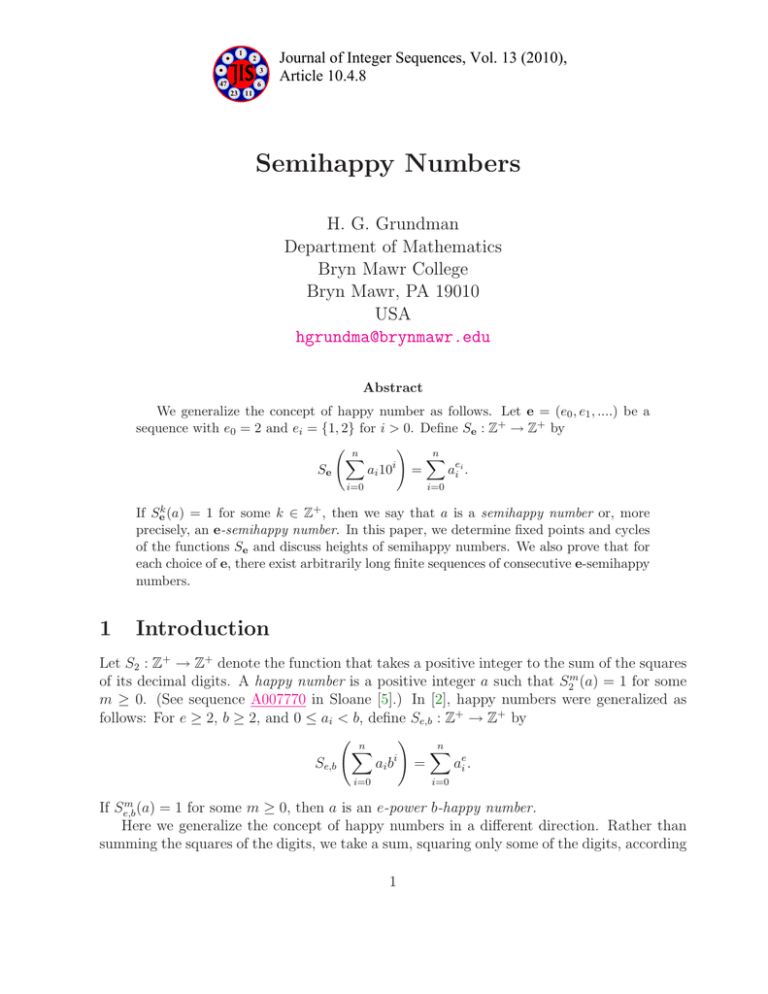Semihappy Numbers H. G. Grundman Department of Mathematics Bryn Mawr College
advertisement

1
2
3
47
6
Journal of Integer Sequences, Vol. 13 (2010),
Article 10.4.8
23 11
Semihappy Numbers
H. G. Grundman
Department of Mathematics
Bryn Mawr College
Bryn Mawr, PA 19010
USA
hgrundma@brynmawr.edu
Abstract
We generalize the concept of happy number as follows. Let e = (e0 , e1 , ....) be a
sequence with e0 = 2 and ei = {1, 2} for i > 0. Define Se : Z+ → Z+ by
!
n
n
X
X
Se
ai 10i =
aei i .
i=0
i=0
If Sek (a) = 1 for some k ∈ Z+ , then we say that a is a semihappy number or, more
precisely, an e-semihappy number. In this paper, we determine fixed points and cycles
of the functions Se and discuss heights of semihappy numbers. We also prove that for
each choice of e, there exist arbitrarily long finite sequences of consecutive e-semihappy
numbers.
1
Introduction
Let S2 : Z+ → Z+ denote the function that takes a positive integer to the sum of the squares
of its decimal digits. A happy number is a positive integer a such that S2m (a) = 1 for some
m ≥ 0. (See sequence A007770 in Sloane [5].) In [2], happy numbers were generalized as
follows: For e ≥ 2, b ≥ 2, and 0 ≤ ai < b, define Se,b : Z+ → Z+ by
!
n
n
X
X
i
ai b =
Se,b
aei .
i=0
i=0
m
If Se,b
(a) = 1 for some m ≥ 0, then a is an e-power b-happy number.
Here we generalize the concept of happy numbers in a different direction. Rather than
summing the squares of the digits, we take a sum, squaring only some of the digits, according
1
to a preset pattern. More precisely, let e = (e0 , e1 , ....) be a sequence with e0 = 2 and
ei ∈ {1, 2}, for i > 0. Define Se : Z+ → Z+ by
!
n
n
X
X
i
ai 10 =
Se
aei i .
i=0
i=0
If Sek (a) = 1 for some k ∈ Z+ , then we say that a is a semihappy number or, more precisely,
an e-semihappy number.
Although the functions Se depend heavily on the value e, we can still prove a number of
results about semihappy numbers in general.
In Section 2, we find all fixed points and cycles for the functions Se and the smallest
semihappy numbers of various heights. Then in Section 3, we prove that for each choice of
e, there exist arbitrarily long finite sequences of e-semihappy numbers.
2
Fixed Points, Cycles, and Heights
Theorem 1 gives the fixed points and cycles of the function Se , for each e. The proof follows
standard techniques. We first show that for each a ≥ 100, Se (a) < a and so, for each a ∈ Z+ ,
there exists some m ∈ Z+ such that Sem (a) < 100. The cycles can then be determined by
applying powers of Se to each a < 100. Note that the second part of the theorem generalizes
the well known result for the function used in defining happy numbers.
Theorem 1. Given e with e1 = 1, the function Se has two fixed points, 1 and 89, and one
nontrivial cycle, 9 7→ 81 7→ 9.
Given e with e1 = 2, the function Se has one fixed point, 1, and one nontrivial cycle,
4 7→ 16 7→ 37 7→ 58 7→ 89 7→ 145 7→ 42 7→ 20 7→ 4.
P
Proof. Let a ≥ 100. Then we have a = ni=0 ai 10i , with n ≥ 2, an 6= 0, and 0 ≤ ai ≤ 9 for
0 ≤ i < n. So
a − Se (a) =
n
X
i
ai 10 −
i=0
=
≥
X
X
n
X
aei i
i=0
ai (10 − aiei −1 )
i
ai (10i − ai )
≥ an (10n − an ) + a0 (1 − a0 )
≥ 99 − 72 > 0
So if a ≥ 100, a > Se (a). Since the equality is strict, this implies that for each a ∈ Z+ , there
exists some m ∈ Z+ such that Sem (a) < 100. A direct calculation for each a < 100 completes
the proof.
Generalizing the definition of the height of a happy number, the e-height of an esemihappy number, a, is the number of iterations of Se needed to reach 1:
he (a) = min{k ∈ Z+ | Sek (a) = 1}.
2
For example, for e with e1 = 1, Se (92) = 13, Se2 (92) = 10, and Se3 (92) = 1. So the e-height
of 92 is 3.
Using a simple computer search, we determined the least e-semihappy numbers of given
heights for each possible e. The results are given in Table 1.
Table 1: Least e-semihappy numbers of given e-heights
Height
0
1
2
3
4
5
e1 = 1
e1 = 2
1
1
10
10
13
13
43
23
76
19
288 or 398
7
The global height of a semihappy number, a, is
h(a) = min{k ∈ Z+ | Sek (a) = 1}.
e
In Table 2, we list the smallest numbers of each global height less than nine, along with the
value of e at which the minimum is achieved. (In the table, trailing dots in the definition
of e indicates that every value of e matching what is given up to that point works.) The
results through height seven are easily verified with a computer search. We prove the result
for height eight below.
Table 2: Least numbers of given global heights
Height least number
e
0
1
(2, ...)
1
10
(2, ...)
2
13
(2, ...)
3
23
(2, 2, ...)
4
19
(2, 2, ...)
5
7
(2, 2, ...)
6
212
(2, 2, 1...)
7
7199
(2, 2, 1, 2...)
8
8 |99 .{z
. . 99} 799 e = (2, 2, 1, 2, 2 . . . , 2, 2, . . . )
| {z }
86
87
Theorem 2. The least semihappy number of height 8 is
A = 8 |99 .{z
. . 99} 799.
86
3
Proof. Suppose that a ≤ A and has height 8. Since a ≤ A, either a has exactly 89 9’s
and at most one digit less than 8, so that Se (a) ≤ 72 + 89 · 92 = 7258, or a has at most
90 digits and fewer than 89 9’s, so that Se (a) ≤ 2 · 82 + 88 · 92 = 7256. Since a has
height 8, Se (a) has height 7 and thus Se (a) ≥ 7199. But if 7200 ≤ Se (a) ≤ 7258, then
Se2 (a) ≤ 72 +22 +52 +92 = 159 < 212, and so Se2 (a) is not of height 6, which is a contradiction.
Thus Se (a) = 7199 and e = (2, 2, 1, 2...). Since at least one digit is not being squared,
a direct calculation shows that a must have exactly 88 9’s, one 8, and one 7, the 7 being
the only digit that is not being squared. The smallest possible such number is A with
e = (2, 2, 1, 2, 2 . . . , 2, 2, . . . ).
| {z }
87
3
Consecutive Semihappy Numbers
In this section we prove that for each e, there exist arbitrarily long finite sequences of
consecutive e-semihappy numbers. This result was proved in the special case of happy
numbers by El-Sedy and Siksek [1]. (See [3], [4] and [6] for alternative proofs and proofs of
similar results for generalized happy numbers.) Before stating and proving the main theorem,
we need some definitions and lemmas, which parallel closely ones found in [3].
Let I : Z+ → Z+ be defined by I(n) = n + 1. For a fixed e, we say that a set D of
integers is e-good, if there exist n, k ∈ Z+ such that for each d ∈ D, Sek (d + n) = 1.
Lemma 3. Fix e and a finite set D. Let F : Z+ → Z+ be the composition of a finite sequence
of Se and I. If the set F (D) is e-good, then D is e-good.
Proof. It follows immediately from the definition of e-good that if I(D) is e-good, then D is
e-good. Using induction on the length of the sequence of functions, it suffices to show that
if Se (D) is e-good, then D is e-good.
Suppose that Se (D) is e-good. Then there exist n′ and k ′ such that for all s ∈ Se (D),
′
Sek (s + n′ ) = 1. Let
n = |11 .{z
. . 11} 00 . . . 00,
n′
where the number of zeros is the number of digits of the largest element of D. Then Se (n) =
n′ and for each d ∈ D, Se (d + n) = Se (d) + n′ . Let k = k ′ + 1. Then for all d ∈ D,
′
′
Sek (d + n) = Sek (Se (d + n)) = Sek (Se (d) + n′ ) = 1.
So D is e-good.
Theorem 4. For each e, there exist arbitrarily long sequences of consecutive e-semihappy
numbers.
Proof. Given m ∈ Z+ , set D = {1, 2, . . . , m}. We prove that D is e-good for any e.
First, suppose e1 = 1. By Theorem 1, there exists some k ∈ Z+ such that for all d ∈ D,
k
Se (d) ∈ {1, 9, 81, 89}. Let F = Se18 I 91 . Then F (1) = F (9) = 1, F (81) = 9, and F (89) = 81.
So
F 3 Sek (D) = F 3 ({1, 9, 81, 89}) = F 2 ({1, 9, 81}) = F ({1, 9}) = {1}.
4
Now, suppose e1 = 2. Again, by Theorem 1, there exists some k ∈ Z+ such that for all
d ∈ D, Sek (d) ∈ {1, 4, 16, 20, 37, 42, 58, 89, 145}. Let F = Se7 I 22 . Then
F 5 Sek (D) =
=
=
=
=
=
F 5 ({1, 4, 16, 20, 37, 42, 58, 89, 145})
F 4 ({1, 4, 20, 42, 58, 145})
F 3 ({1, 20, 42, 145})
F 2 ({1, 20, 145})
F ({1, 145})
{1}
In either case, by Lemma 3, D is e-good. Thus there exist n and k ∈ Z+ such that for
each d ∈ D, Sek (d + n) = 1 and, therefore, n + 1, n + 2, . . . , n + m are all e-semihappy. So
for any m ∈ Z+ , there exists a sequence of m consecutive e-semihappy numbers.
References
[1] E. El-Sedy and S. Siksek, On happy numbers, Rocky Mountain J. Math., 30 (2000),
565–570.
[2] H. G. Grundman and E. A. Teeple, Generalized happy numbers, Fibonacci Quart., 39
(2001), 462–466.
[3] H. G. Grundman and E. A. Teeple, Sequences of consecutive happy numbers, Rocky
Mountain J. Math., 37 (2007), 1905–1916.
[4] H. Pan, On consecutive happy numbers, J. Number Theory, 128 (2008), 1646–1654.
[5] N. J. A. Sloane,
The On-Line Encyclopedia of Integer Sequences,
http://www.research.att.com/~njas/sequences/.
2010,
[6] X. Zhou and T. Cai, On e-power b-happy numbers, Rocky Mountain J. Math., 39 (2009),
2073–2081.
2010 Mathematics Subject Classification: Primary 11A63.
Keywords: happy numbers, semihappy numbers.
(Concerned with sequence A007770.)
Received April 7 2010; revised version received April 12 2010. Published in Journal of Integer
Sequences, April 15 2010.
Return to Journal of Integer Sequences home page.
5





